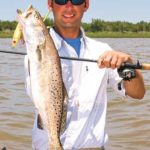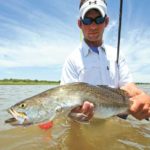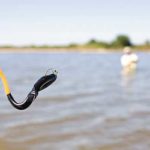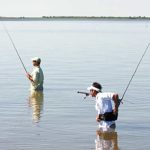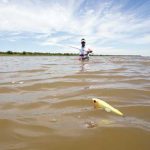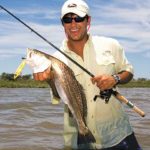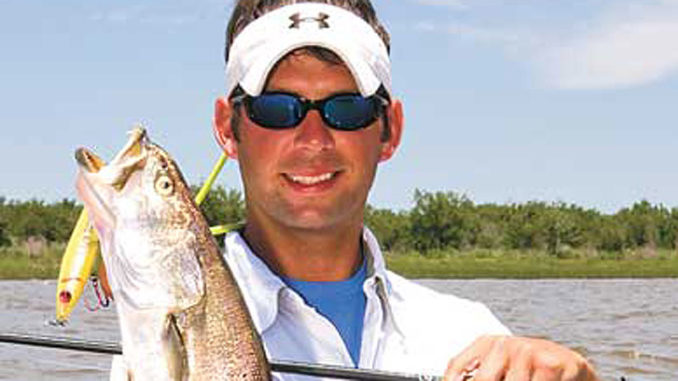
Get out of the boat, and follow these eight tips to catch fish that’ll make you a STAR contender.
Taking a topwater to the crotch doesn’t sound like something a speckled trout angler would have to worry about. Sling a trout in the boat, let him flop around on the floor, grab him and unhook him. Throw him on ice and repeat while the topwater stays a safe distance away.However, John Solari has taken a few topwaters where the sun doesn’t shine in the last year or two while reeling in speckled trout. Fortunately, neither he nor his posterity had much to worry about because the hooks didn’t go all the way through his waders.
Did I mention he was wading? If you know Solari, that fact was assumed. Solari and his good friend Stephen Lanza are quickly becoming known for catching big Calcasieu Lake trout while doing the stingray shuffle.
In fact, outside their studies at McNeese State University, their free time is spent fishing in the Coastal Conservation Authority STAR tournament, and they readily admit that they pre-fish for the tournament all year long. Their favorite way of fishing before and during the tournament is by jumping out of a perfectly stable bay boat and wading in the water.
Why wade fishing? According to Solari, it’s because they believe they are doing themselves a huge favor by concealing themselves in the water while carrying their fishing gear. Wade fishing allows them to quietly present big baits to big trout, and the STAR tournament, in the minds of these two young anglers, is all about big trout.
“You can catch big trout out of a boat,” said Solari, “but the odds aren’t in your favor. Bait and fish scatter when a boat drifts overhead much like they do when a pelican passes overhead. When you’re wade fishing, neither the trout nor the bait will spook. Trout will sometimes swim right by you because you’re a less-imposing presence in the water than you are in a boat.”
Wade fishing is an angler’s opportunity to blend into his or her surroundings much like a hunter would by climbing into a camouflaged blind. Small fish and animals might not mind too much that you stand out, but the biggest of each will mind, and they’ll hightail it to a more secluded area in an effort to get away from you.
Whereas many anglers pull up to a spot they want to fish and hurriedly make four or five casts before deciding that the spot doesn’t hold any trout, wade fishing anglers don’t have the luxury of abandoning a spot too quickly.
Rather than hop back in the boat and speed off to another spot, they know their best chance of catching a big fish is in making the most of the spot they are fishing right now rather than the one they could be fishing.
Lanza believes it’s not a style of fishing that suits every angler.
“We’ve seen a lot of new people out here wading the last few months,” he said, “but for whatever reason, they don’t seem to stick with it. You’ve got to have a lot of patience to do what John and I do because we’re specifically fishing for big trout. Rather than going out and trying to catch a bunch of fish, 10 bites would be a good trip for us.”
In other words, wade fishing requires a trophy-hunter mentality. He or she has to be willing to forego the masses for the few.
So how did Solari and Lanza acquire this trophy mentality? According to Lanza, it all started back when they saw the angling pressure increase.
“We knew we had to do something different to get away from all the boats,” he said. “And the more we waded, the more big trout we caught, especially when we waded really shallow water where it would be hard to get into with a big boat. The key to catching those really big trout on a consistent basis is to try to isolate yourself as much as possible.”
During the last couple of years, Solari and Lanza have learned a few things about wade fishing that will increase your chances of catching a big trout this summer no matter where you fish.
Their advice will help you catch big trout whether you’re fishing the flats on Calcasieu Lake, the surf at Grand Isle or even Breton Island. And they just might help you vault to the top of the STAR leaderboard this summer.
1. Wade near deep water
Prefacing that advice by explaining that an angler wading the flats off the ship channel would walk in over his head before falling down a drop-off, Solari and Lanza emphasized that wade fishing during the summer requires fishing a feeding flat that is near deep water.
“When the water gets hot, those big trout are going to hang out in the cooler, deeper water and move onto the nearby shallow flats to feed,” said Lanza. “When they get done, they’ll move right back to the deep water. Bigger fish, especially, have to have that access to deep water.”
2. Wade near bait
“You’ve got to have the baitfish if you want to catch trout whether you’re wade fishing or fishing from a boat,” said Solari. “I would say we look for mullet 90 percent of the time. They don’t have to be nervous or skipping across the surface; we just have to see mullet in the area.”
Solari also said the presence of slicks on the surface are crucial during the summer because they mean that all the pieces of the puzzle are coming together. Not only do slicks indicate the presence of baitfish, they indicate the presence of fish that are feeding on the baitfish.
3. Wade concentration zones
Some things just tend to concentrate bait, which in turn concentrates trout. A few things that Solari and Lanza look for are areas where dirty and clear water are mixing, current lines and windy banks.
“Say we’re fishing a cove on the west side of a lake with a light northeast wind blowing into it,” said Solari. “The waves are crashing against the bank, and we’re going to look for bigger trout on that bank because the waves will pile up the bait on that bank in the roughest spot.”
And if you find yourself fishing a mixing area with clear and dirty water, Solari said to stand in the dirty water and throw into the clear. Expect your bites to come near the line on the clear side.
4. Wade near end of high tide
“No tide, no hits,” Solari insisted. “If we can get any kind of tide in the afternoon, that’s a good thing. But our favorite time to be in the water is at the end of an incoming tide right before it starts pouring out.”
The end of the incoming tide will be the highest the water will be on feeding flats, and trout will push up into these shallow areas to take advantage of the bait that moved in there too.
5. Wade the middle of the day
Solari and Lanza have caught a lot of big trout in the afternoon hours between 2 and 6 p.m. when most anglers have long hightailed it back to the AC at the camp. Lots of folks who come out before first light get burned out by 11 a.m., and that’s why these guys like fishing the afternoon.
“During the summer, we really don’t get out on the water until about 2 p.m.,” said Lanza. “When you’re hitting fish late in the afternoon like this, not only are you fishing less-pressured fish, but you can get the timing down as to when the trout are biting in certain areas because you don’t have to worry about as many boats messing them up.”
6. Suffer the smaller specks
While most wouldn’t consider it suffering to catch a bunch of trout no matter what size they are, Solari believes too many big-trout anglers leave a spot full of small specks too quickly.
“If you know the spot holds big trout but you’re only catching small ones, stay there,” he advised. “The big trout might not be eating because the smaller fish are a lot more aggressive than the big, lazy sow trout.
“Those big trout want to eat a 12-inch mullet and not eat the rest of the day, and if you’re standing in the water when that big fish gets ready to eat, you could catch it.”
7. Cast with the wind
Lanza says the biggest trout he’s caught while wade fishing have hit at the end of very long casts. That’s why he fishes areas with what he called a perfect wading wind. Simply put, if he likes a west wind when fishing a west bank and an east wind when fishing an east bank.
“Not only will it be calmer with the perfect wading wind,” he said, “but you’ll be able to cast your baits farther away from you and catch bigger trout.
“That’s also why we use 7-foot rods while wade fishing. You can make an extremely long cast with a long rod with the wind, and you’re going to get your biggest bites at the ends of those long casts.”
8. Carry two rods
Solari wears a wading belt when wade fishing to help him keep everything organized and in its place. Aside from being able to carry stuff like his BogaGrip and extra tackle, the best part about it, in his opinion, is that it has a holder for an extra rod.
“I keep either a topwater or suspending bait tied on one and a big Norton Sand Eel on the other,” he said. “Trout will sometimes just slash at the plugs without getting hooked up. With that extra rod in its holder, I can quickly throw the Sand Eel in there on that same fish and catch it most of the time.”
Solari and Lanza admit wade fishing won’t automatically thrust you to the top of the STAR leaderboard. Their own past performances prove that. But they have been close, very close, and they have probably caught more trout just under the cut than anyone.
Wade fishing will help you catch bigger trout, but catching THE trout — well that’s just a matter of luck. However, Solari and Lanza believe wade fishing will one day help them make their own luck.
